
Radegund was a Thuringian princess and Frankish queen, who founded the Abbey of the Holy Cross at Poitiers. She is the patroness saint of several churches in France and England and of Jesus College, Cambridge.

King Street is a street in central Cambridge, England. It connects between Sussex Street heading west and Hobson Street heading south at the western end and a large roundabout to the east. It runs parallel to and south of Jesus Lane. The roads link together at a roundabout at the eastern end. To the east is Maid's Causeway and then Newmarket Road leading out of Cambridge. To the north is Victoria Avenue between Jesus Green and Midsummer Common. To the south is Short Street, Cambridge, quickly leading into Emmanuel Road past Christ's Pieces.

The University Pitt Club, popularly referred to as the Pitt Club, the UPC, or merely as Club, is a private members' club of the University of Cambridge. It was formerly male-only, and has admitted women since 2017.

Turl Street is a historic street in central Oxford, England.
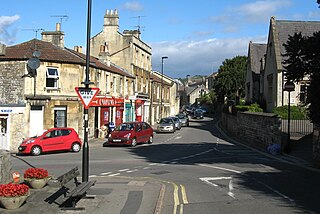
Weston is a suburb and electoral ward of Bath in Bath and North East Somerset, South West England, located in the northwest of the city. Originally a separate village, Weston has become part of Bath as the city has grown, first through the development of Lower Weston in Victorian times and then by the incorporation of the village into the city, with the siting of much local authority housing there in the period after World War II.

Charles Eamer Kempe was a British Victorian era designer and manufacturer of stained glass. His studios produced over 4,000 windows and also designs for altars and altar frontals, furniture and furnishings, lychgates and memorials that helped to define a later nineteenth-century Anglican style. The list of English cathedrals containing examples of his work includes: Chester, Gloucester, Hereford, Lichfield, Wells, Winchester and York. Kempe's networks of patrons and influence stretched from the Royal Family and the Church of England hierarchy to the literary and artistic beau monde.

St Botolph-without-Bishopsgate is a Church of England church in the Bishopsgate Without area of the City of London, and also, by virtue of lying outside the city's eastern walls, part of London's East End.
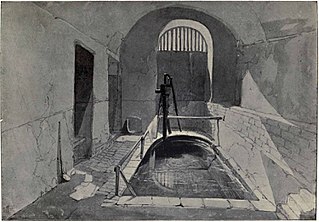
The Strand Lane Baths, at 5 Strand Lane, London WC2R 2NA, have been reputed since the 1830s to be a Roman survival. They are in fact the remaining portion of a cistern built in 1612 to feed a fountain in the gardens of the old Somerset House, then a royal place. After a long period of neglect and decay, following the demolition of the fountain, they were brought back into use in the 1770s as a public cold plunge bath, attached to No. 33 Surrey Street. The idea that they were Roman probably began some fifty years later as an advertising gimmick, and has aroused both enthusiasm and scepticism ever since.

All Saints' is a church on Jesus Lane in central Cambridge, England, which was built by the architect George Frederick Bodley. The church was constructed in stages between 1863 and 1870 and is a notable example of English Gothic Revival style. It was designated Grade I listed building status in 1950. It was vested in the Churches Conservation Trust in 1981. Opening times vary and visitors should contact the Churches Conservation Trust to confirm current arrangements.
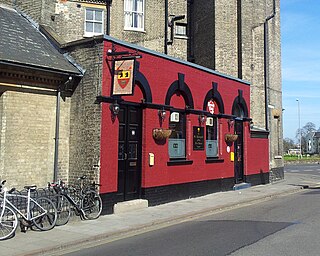
St Radegund is a pub in King Street, Cambridge, England. It is named after St Radegund, a Frankish saint associated with the nearby Jesus College.
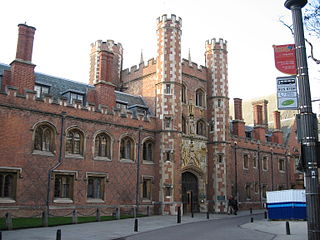
St John's Street is a historical street in central Cambridge, England. The street links with Bridge Street, Round Church Street, and Sidney Street to the north. It continues to the south as Trinity Street, then King's Parade and Trumpington Street. This thoroughfare is the main area for some of the most historic University of Cambridge colleges.

Sidney Street is a major street in central Cambridge, England. It runs between Bridge Street at the junction with Jesus Lane to the northwest and St Andrew's Street at the junction with Hobson Street to the southeast.

Bene't Street is a short historic street in central Cambridge, England, the name being derived from St Benedict. There is a junction with King's Parade to the north and Trumpington Street to the south at the western end of the street. Free School Lane leads off to the south. To the east, the street continues as Wheeler Street.
Bridge Street is a historic street in the north of central Cambridge, England. It runs between Magdalene Street at the junction with Thompson's Lane to the northwest and Sidney Street at the junction with Jesus Lane to the southeast. Bridge Street used to continue over the Great Bridge on the River Cam, hence the name, but this part is now known as Magdalene Street after Magdalene College, which fronts onto the street.

Newmarket Road is an arterial road in the east of Cambridge, England. It is designated the A1134 at the western end, linked by a roundabout forming a junction with Barnwell Road (A1134) to the south. The eastern end links with the city's inner ring road at another roundabout, with Elizabeth Way (A1134) to the north and East Road (A603) to the southeast. Newmarket Road continues a short way towards the city centre, becoming Maid's Causeway and then Jesus Lane. To the east, the road becomes the A1303 and crosses the A14 at a major roundabout, continuing further east and parallel to the A14 out of the city. The road is named after the market town of Newmarket in Suffolk, east of Cambridge.

St Radegund's Priory, Cambridge was a Benedictine nunnery in Cambridge, Cambridgeshire, England. It was founded before 1144 and dissolved in 1496 by the initiative of John Alcock, Bishop of Ely.

The following is a timeline of the history of the city of Cambridge, England.

St Clement's is a Church of England parish church in central Cambridge. The church is a Grade II* listed building.
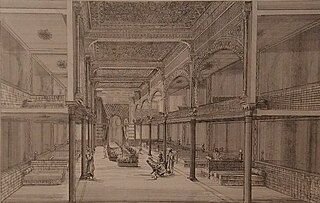
The Victorian Turkish bath is a type of bath in which the bather sweats freely in hot dry air, is then washed, often massaged, and has a cold wash or shower. It can also mean, especially when used in the plural, an establishment where such a bath is available.




















